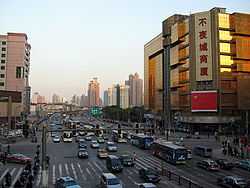Zhabei District
| Zhabei 闸北 | |
|---|---|
| District | |
闸北区 | |
 | |
 | |
| Country | China |
| Region | Shanghai |
| Time zone | China Standard (UTC+8) |
| Zhabei District | |||||||||||||
| Simplified Chinese | 闸北区 | ||||||||||||
|---|---|---|---|---|---|---|---|---|---|---|---|---|---|
| Traditional Chinese | 閘北區 | ||||||||||||
| Wu | zah入poh入 chiu平 | ||||||||||||
| |||||||||||||
Zhabei District (simplified Chinese: 闸北区; traditional Chinese: 閘北區; Shanghainese: zah poh chiu) of Shanghai has a land area of 29.26 km² and a resident population of 810,211 as of 2003. It is one of the downtown districts of Shanghai though the commercial potential has been continuously undervalued. Facilitated with the Shanghai Railway Station, which used to be the only railway terminal of Shanghai (until the completion of Shanghai South Railway Station in 2006), Zhabei District is famous for its connectivity, which becomes the reason hi-tech and creative industries begin to accumulate in the district.
Historically, the district has been highly populated with working class residents. However, due to the shift in the structure of industries and increasing number of immigrants from outside Shanghai, partly due to its reasonable real estate price (compared to its counterparts such as Putuo and Hongkou), the district has become increasingly appealing to city residents.
History
Richard Evans, author of Deng Xiaoping and the Making of Modern China (first edition 1993) said that he used the spelling Chapei for Zhabei in his book, along with other older spellings, because that name had been used for Anglophones for a long period of time and "to continue to use them is comparable to go on to using Vienna for Wien or Venice for Venezia."[1]

Economy
Zhabei local authorities have developed business and commercial centres in the district. It has attracted various foreign companies to build offices, apartments and commercial retail outlets over there.
It is also where the Shanghai Multimedia Valley (SMV) is located to attract media and IT talent. Major companies located in Zhabei include TÜV Rheinland, Royal Philips Electronics and Shanghai Bell Alcatel Business Systems Co., LTD.[2]
Subdistricts and town
Subdistricts: West Tianmu Road Subdistrict (天目西路街道), Beizhan Subdistrict (北站街道), Baoshan Road Subdistrict (宝山路街道), West Zhijiang Road Subdistrict (芷江西路街道), Gonghexin Road Subdistrict (共和新路街道), Daning Road Subdistrict (大宁路街道), Pengpu New Village Subdistrict (彭浦新村街道), Linfen Road Subdistrict (临汾路街道).[3]
Town: Pengpu Town (彭浦镇).
Facilities
Zhabei District used to be the place of agglomeration of traditional industries such as flavor factory and tires factory. In the last decade, the municipality decided to move the old industry out in order to make space for more promising ones such as the hi-tech and creative industries.
Daning Lingshi Park, the biggest green area in the downtown area, is surrounded [4] by a series of cultural facilities such as the Zhabei Stadium and Shanghai Circus World.
In the adjacency to Daning Linshi Park situates the Shanghai University.
References
- ↑ Evans, Richard. Deng Xiaoping and the Making of Modern China. Penguin Books, 1995. Second Edition. Page xi. ISBN 0 14 01.3945 1 - The first edition is dated 1993
- ↑ "A Survey about Zhabei District". Zhabei authority. Retrieved 2010-11-02.
- ↑ "闸北区-行政区划网 www.xzqh.org" (in Simplified Chinese). XZQH. Retrieved 2012-05-24.
- ↑ Shanghai Zhabei Government Portal - www.shzb.gov.cn/en
Further reading
- "Zhabei District". Encyclopedia of Shanghai. Shanghai Municipal Government. 2010.
External links
- Shanghai Zhabei Government Portal
- Shanghai Circus World
| |||||||||||||||||||||||||||||||||||||||||||||||||||||||
Coordinates: 31°15′08″N 121°27′32″E / 31.2522°N 121.459°E